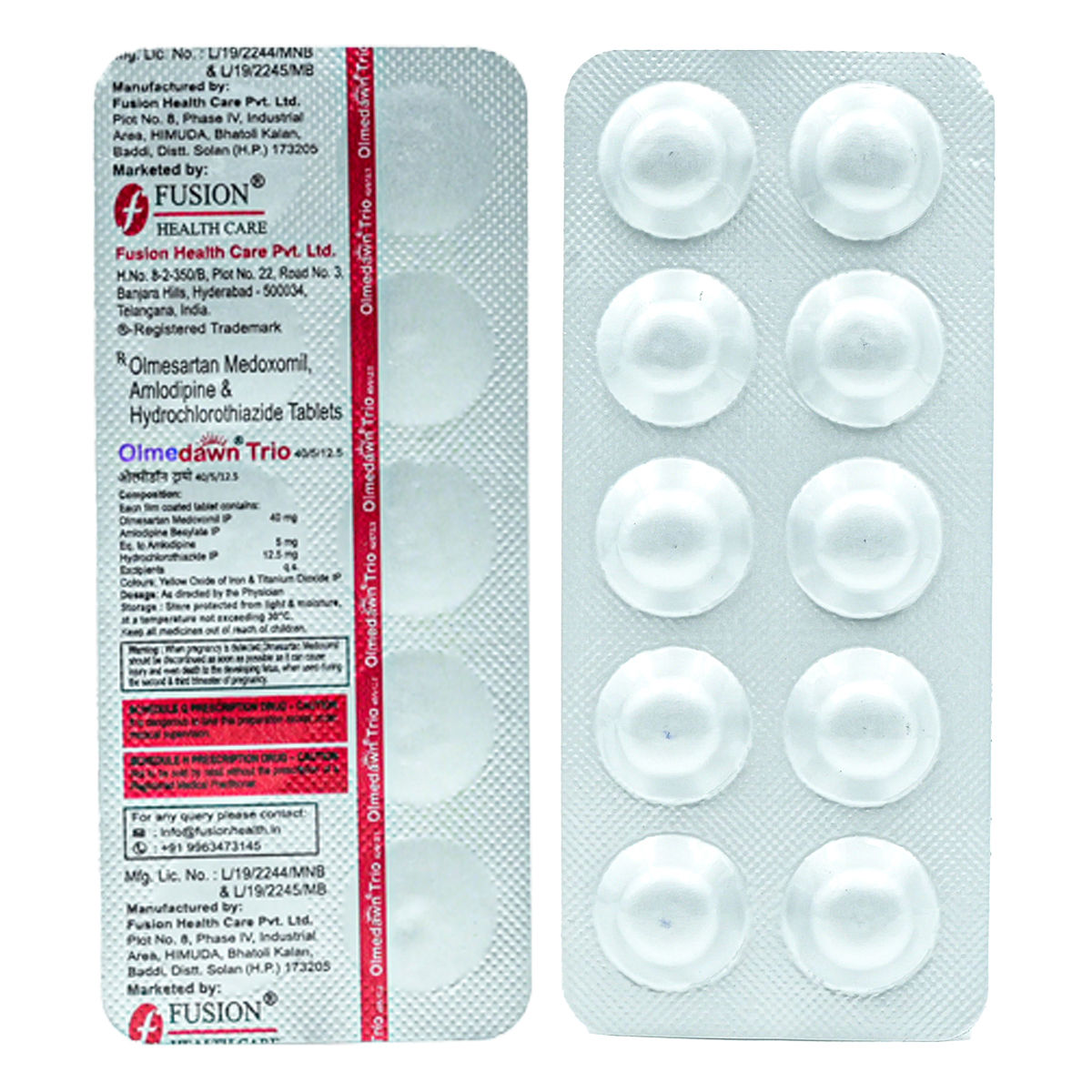Olmat 40 AMH Tablet 10's
₹244.8*
MRP ₹272
10% off
₹210.8*
MRP ₹272
15% CB
₹61.2 cashback(15%)
Free Delivery
With Circle membership
(Inclusive of all Taxes)
This offer price is valid on orders above ₹800. Apply coupon PHARMA10/PHARMA18 (excluding restricted items)
Know Your Delivery Time
Provide Delivery Location





Selected Pack Size:10
10 ₹367.2
(₹36.72 per unit)
In Stock
15 ₹367.2
(₹24.48 per unit)
In Stock
Whats That

Secure Payment

India's Most Trusted Pharmacy

Genuine Products
Manufacturer/Marketer :
Consume Type :
Return Policy :
Expires on or after :
About Olmat 40 AMH Tablet
Olmat 40 AMH Tablet belongs to a group of medications called 'anti-hypertensives' primarily used for lowering high blood pressure (hypertension) by removing extra fluid (electrolytes) from the body. High blood pressure is a chronic condition in which the blood's force against the artery wall is high. As a result, it increases the risk of heart-related diseases like heart attack, heart failure, stroke, irregular heartbeat, and other complications.
Olmat 40 AMH Tablet is a combination of three medicines: Olmesartan medoximil, Amlodipine, and Hydrochlorothiazide. Olmesartan medoximil is a prodrug and breaks down into active form, i.e., olmesartan once absorbed in the GIT (Gastrointestinal tract). An angiotensin receptor blocker (ARB) blocks the hormone angiotensin, thereby relaxing and widening the narrowed blood vessels. Amlodipine is a calcium channel blocker; it reduces the heart's workload and makes it more efficient at pumping blood throughout the body. Hydrochlorothiazide is a diuretic or water pill that removes extra water/fluid and certain electrolyte overload from the body. Together, Olmat 40 AMH Tablet lowers fluid overload, raises blood pressure, improves blood flow, and reduces the future risk of a heart attack and stroke.
Depending upon your medical condition, you are advised to take Olmat 40 AMH Tablet for as long as your doctor has prescribed it for you. The most common side effects of Olmat 40 AMH Tablet are nausea, upset stomach, dehydration, headache, diarrhoea, electrolyte imbalance, headache, feeling exhausted, swollen ankles, dizziness, and decreased blood pressure in some cases. Most of these side effects of Olmat 40 AMH Tablet do not require medical attention and gradually resolve over time. However, if the side effects are persistent, reach out to your doctor.
Do not use potassium supplements or salt substitutes unless your doctor tells you. In rare cases, Olmat 40 AMH Tablet can cause a condition that results in a skeletal muscle problem, leading to further kidney failure. If you notice unexplained muscle pain, dark-coloured urine, tenderness, or weakness, especially if you also have a fever or unexplained tiredness, immediately contact the doctor. Try not to stop taking this medicine of your own. Let your doctor know about this, as it may cause a rise in blood pressure and increase heart disease and stroke risk. Inform your doctor if you are suffering from kidney, liver, heart disease, or diabetes. If you are pregnant or breastfeeding, do not take Olmat 40 AMH Tablet as it is a category D pregnancy drug and may harm the baby. Do not use the Olmat 40 AMH Tablet if you cannot urinate, are dehydrated, have low blood pressure (hypotension), or have had cardiogenic shock (sudden stopping blood flow to the heart). Please tell your doctor if you are taking any other medicines or are allergic to this medicine. Reducing table salt (sodium chloride) in your food often helps lower blood pressure.
Uses of Olmat 40 AMH Tablet
Medicinal Benefits
Olmat 40 AMH Tablet belongs to a group of medications called 'anti-hypertensives' primarily used for lowering high blood pressure (hypertension) by removing extra fluid (electrolytes) from the body. Olmat 40 AMH Tablet is a combination of three medicines: Olmesartan medoximil, Amlodipine, and Hydrochlorothiazide. Olmesartan medoximil is a prodrug and breaks down into active form, i.e., olmesartan once absorbed in the GIT (Gastrointestinal tract). An angiotensin receptor blocker (ARB) blocks the hormone angiotensin, thereby relaxing and widening the narrowed blood vessels. Amlodipine is a calcium channel blocker; it reduces the heart's workload and makes it more efficient at pumping blood throughout the body. Hydrochlorothiazide is a diuretic or water pill that removes extra water/fluid and certain electrolyte overload from the body. Together, Olmat 40 AMH Tablet lowers fluid overload, raises blood pressure, improves blood flow, and reduces the future risk of a heart attack and stroke.
Side Effects of Olmat 40 AMH Tablet
Nausea
Upset stomach
Dehydration
Headache
Dry mouth
Muscle cramps/weakness
Fast/slow/irregular heartbeat
Diarrhoea
Electrolyte imbalance
Headache
Feeling exhausted
Swollen ankles
Dizziness
Decreased blood pressure
Directions for Use
Storage
Drug Warnings
Do not use Olmat 40 AMH Tablet if you are pregnant, planning for pregnancy, or unable to urinate (anuria). If you have diabetes and taking Olmat 40 AMH Tablet with other blood pressure-lowering pills like 'aliskiren,' immediately stop taking both together and consult a doctor. Besides this, it is contraindicated in low blood pressure (hypotension), cardiogenic shock (sudden stopping of blood flow to the heart), and aortic stenosis (heart valve problem). Olmat 40 AMH Tablet may pass into breast milk, so before starting Olmat 40 AMH Tablet , either you need to stop nursing or you should not take Olmat 40 AMH Tablet while breastfeeding. Please inform your doctor before surgery if you are taking Olmat 40 AMH Tablet as it needs to be stopped because it might lower the blood pressure further if taken along with local anaesthesia. Avoid potassium salt or its substitute intake while using Olmat 40 AMH Tablet to avoid any electrolyte imbalance. Olmat 40 AMH Tablet can pass into breast milk, but its effect on the baby is unknown. So, it is better to tell your doctor if you take Olmat 40 AMH Tablet and breastfeeding.
Therapeutic Class
Drug-Drug Interactions
Drug-Food Interactions
Diet & Lifestyle Advise
Create a well-balanced and healthy diet that includes vegetables, fruits, whole grains, legumes, omega-3-rich foods, and lean protein sources.
Keep your weight under control with a BMI of 19.5-24.9.
Avoid chronic stress, as it can raise your blood pressure.
Spend time with your loved ones to cope with stress and practice mindfulness techniques.
Be mindful of salt; consume no more than 2,300 mg each day.
Limit or avoid alcohol consumption.
Quitting smoking is the best strategy to lower the risk of heart disease.
Habit Forming
How Olmat 40 AMH Tablet Works
What if I have taken an overdose of Olmat 40 AMH Tablet
Alcohol
Unsafe
You are recommended not to consume alcohol and Olmat 40 AMH Tablet to avoid unpleasant side effects like drowsiness, dizziness, and liver damage.
Pregnancy
Unsafe
Olmat 40 AMH Tablet is not recommended during pregnancy as it contains Olmesartan, which is a category D pregnancy drug. This medicine may cause fetal damage and can affect the unborn baby (fetus).
Breast Feeding
Unsafe
Olmat 40 AMH Tablet is known to pass breast milk, but its effect on the baby is unknown. So, before breastfeeding, let your doctor know about this. Either you need to stop breastfeeding for using Olmat 40 AMH Tablet or stop taking Olmat 40 AMH Tablet .
Driving
Caution
Drive with caution; Olmat 40 AMH Tablet usually causes drowsiness and affects driving ability.
Liver
Caution
Olmat 40 AMH Tablet to be taken with caution, especially if you have or have had a history of liver disease. Your doctor will have to change the dosage depending on your medical condition and your reaction to treatment.
Kidney
Caution
Olmat 40 AMH Tablet to be taken with caution, especially if you have had a history of kidney disease. Your doctor will have to change the dosage depending on your medical condition and your reaction to treatment.
Children
Caution
Efficacy and safety of Olmat 40 AMH Tablet have not been established in children. If prescribed, it should be strictly under medical supervision and only if the benefits outweigh the harm.
Country of origin
Manufacturer/Marketer address
Author Details
We provide you with authentic, trustworthy and relevant information
FAQs
Disclaimer
Product Substitutes



















